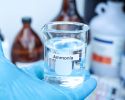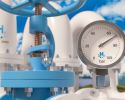HOPE not hype

Hydrogen has in a short time become like climate policy's own Messiah who will save us from our dependence on fossil fuels. But not everything can run on hydrogen. So how well does it work as a shipping fuel? The Nordic co-operation project HOPE is investigating whether the hyped gas is something for roro/ropax ferries.
Recently, major investments have been made in the Hydrogen industry and will also be made in the future through "The European Green Deal". The European Commission is investing 430 billion euros by 2030 to make hydrogen an obvious part of the energy system of the future.
Today, hydrogen is mainly used to refine oil products and to produce ammonia for artificial fertilizers. So we know how it is produced. The problem is that it is mainly made with the help of fossil fuels, mostly it is produced from natural gas. So renewable production needs to be increased, infrastructure and distribution expanded at the same time as the costs must be reduced before hydrogen can have a greater impact as a fuel.
“Even if all this is fulfilled, it will still be problematic if we invest everything in a single type of energy. I believe in a combination of different solutions. There are a variety of possibilities such as electrification, wind, biofuels, and electric fuels. So the question is to what extent hydrogen and fuel cells are an interesting solution for shipping? Which segments is it suitable for?” says Julia Hansson, a researcher at IVL Swedish Environmental Institute.
The HOPE project, which she leads, is looking more closely at whether hydrogen is something to invest in in the ro-ro/ropax segment in the Nordic region. Together with other Nordic researchers and industry players, IVL will, among other things, develop and evaluate a concept design for a ship in short sea shipping that uses hydrogen and fuel cells for propulsion.
"It is a very evaluative project and is not about finding a solution. The idea actually came first from Stena, which is developing the ferry Elektra with a battery-technical solution. Would it work just as well with hydrogen? What are the pros and cons? Can a ship only run on hydrogen or should it have a dual alternative? Of course, the shipping companies are wondering. These are difficult decisions that they are now facing."
Some shipping companies have already decided and invested in LNG - something that has recently received attention because the engines leak methane. Were they too early on the sustainability ball?
"No, as I said, I think you need more alternatives and those who drive on LNG today can eventually switch to LBG (biogas). But it is also about increasing production and reducing methane emissions."
In the project, the developed ship concept will be tested – on everything from technical aspects and costs to barriers and driving forces for this type of vessel to be realized in the Nordic region.
"We also develop different scenarios about what impact it could have on Nordic shipping's greenhouse gas and environmental emissions. How much of the fleet could implement such a solution?"
If it turns out to be a good idea to invest in hydrogen in the ro-ro / ropax segment, how long would it take for such vessels to sail in our Nordic waters?
"I think a lot depends on when new instruments come and what they look like. It will determine when it will be interesting to get such a solution."
HOPE - Hydrogen fuel cells solutions in shipping in relation to other low carbon options -
Is funded through a collaboration between Nordic Energy Research, the Danish EUDP, Business Finland, the Swedish Transport Administration, the Norwegian Research Council and the Icelandic Research Center, as well as significant in-kind from participating companies. The project will run for two years and is carried out by IVL together with Sintef (Norway), the University of Iceland, Stena Rederi and PowerCell Sweden.
Two more projects that will analyze and test hydrogen and ammonia in shipping are financed within the same program.
-
 We are not approaching the transport policy goals
We are not approaching the transport policy goals -
 Time to pave the way for ammonia
Time to pave the way for ammonia -
 Norwegian officers skeptical of autonomous ships
Norwegian officers skeptical of autonomous ships -
 Drones and AI can save lives at sea
Drones and AI can save lives at sea -
 Watch the seminar Nordic Roadmap
Watch the seminar Nordic Roadmap -
 Research money yields manifold returns
Research money yields manifold returns -
 Bike counting at docks could save fuel
Bike counting at docks could save fuel -
 Hydrogen to be cooled with seawater on Gotland ferries
Hydrogen to be cooled with seawater on Gotland ferries -
 New rules needed for handling electric cars on board ships
New rules needed for handling electric cars on board ships -
 ChatGPT lacks spatial sense
ChatGPT lacks spatial sense

